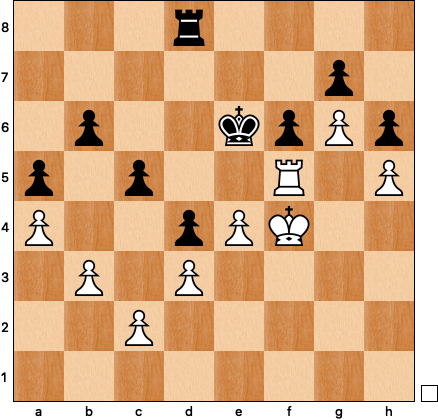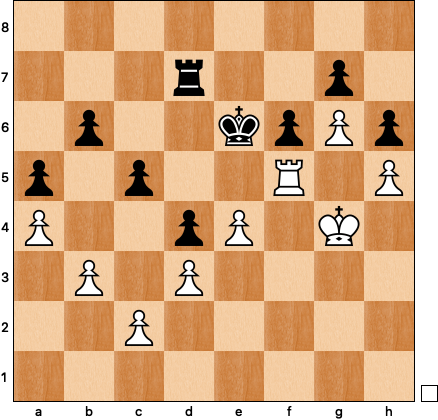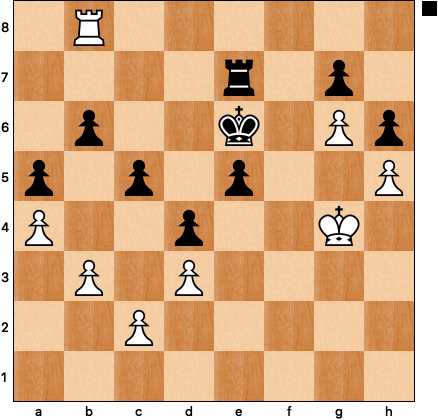Before digging into some chess, congratulations to Carissa Yip, who followed up her victory in the 2024 US Women’s Championship with a compelling come from behind win in the recently completed Cairns Cup. Fellow American Alice Lee was the big story of the first half of the tournament, with wins in the first two rounds, but Yip made up for lost time by scoring a remarkable 4.5/5 to close out the event.
It’s more customary to celebrate the victor by reviewing her best tactics or best game, but I found myself intrigued by Yip’s 118(!) move loss to Harika Dronavalli in the first round. Let’s begin at the start of the rook and pawn ending, a position that looked harmless at first and then more and more poisonous the deeper I analyzed. I went through three stages of work, ignoring the most of the other interesting games in the tournament in the process:
Moving pieces around the board without the help of the computer, writing down my thoughts about positions and evaluations.
Playing a half dozen training games against Stockfish from the starting position.
Comparing my results to engine analysis and the notes to the game from the chess.com article.
Part 1: Analysis without the computer
First impressions: white has the better chances thanks to her advanced kingside pawns, but to make use of them she somehow has to get her rook to f7. There’s no way to do this in the current pawn structure, so Dronavalli is going to have to find the right time to push e4-e5. The current position is not the right time: 89 e5? Rd5 90 exf6? Rxf5+.
Both players were understandably short on time and probably pretty tired, so there was some shuffling before the break: 89 Kf3 Rd6 90 Kg3 Rd8 91 Kg4 Rd7 92 Rf1 Rd8 93 e5:
Mission accomplished! Now we’re going to open a file for white’s rook. Yip played 93 … fxe5 and after 94 Rf7 Rd7 95 Rf8 her position was very difficult to defend.
But wait! Can’t black just play 93 … Kxe5? My initial instinct was to trust the players and search for a refutation, so I found 94 Re1+ Kd6 95 Kf5 Rd7 96 Re6+ Kc7 97 Rxf6 (a tactic!?) 97 … gxf6 98 Kxf6:
In these kinds of positions I tend to get very excited and let white make a lot of moves in a row, so I briefly thought that I’d stumbled on brilliant hidden trap. When I actually played out the position, I realized that the rook sacrifice rebounds: 98 … Kd6 99 g7 Rd8 100 Kf7 Ke5 101 g8=Q Rxg8 102 Kxg8 Kf6 when black wins the h-pawn and the game.
The more I looked at the position, the more certain I was that Yip had missed a big chance — and that Dronavalli could have forced her opponent to capture on e5 with the pawn if she’d timed the initial break better. Let’s go back the position after move 91:
Dronavalli played 92 Rf1, but it appears that 92 e5 would have worked just fine, thanks to 92 … Rd5? 93 exf6! Rxf5 94 fxg7, when black cannot prevent g8=Q next move. This means that 92 … fxe5 is forced, and now 93 Rf8 arrives at the promising position white actually reached on move 95:
We’ve reached a crossroads: black has to make the kind of choice that seems to always appear in these kinds of endgames. Should she A) lash out in a bid for active counterplay or B) act like a turtle and try to defend everything? Yip chose activity with 95 … e4, and the alternatives seemed to back up her choice. 95 … Re7 96 Rb8 looks very bad, as does 95 … Kd6 96 Kf5 or 95 … Kd6 96 Rb8. It’s very difficult to defend both the b6 and g7 weaknesses, and the white king is ready to invade on f5.
However, after 96 dxe4 d3 97 Re8+ Yip was busted, thanks to 97 … Kf6 98 e5#! Her king stepped in front of the rook, 97 … Kd6, allowing Dronavalli to win another pawn and, eventually, the game.
Given all this I decided that 96 … c4 was the best available try, perhaps causing enough confusion to draw. The problem is that 97 dxc4 Rc7 98 Rf7 seems pretty efficient, as black cannot go into the king and pawn endgame:
Part 2: Sparring with Stockfish
I made myself very crazy last year trying to hold one of Matt Gross’s rook and pawn training positions against Stockfish. I’m not going down that rabbit hole again, but I decided to play a series of games against the machine, switching colors each time, until I understood the position better. It can’t possible be as bad as it seemed in my home analysis, can it?
Game one went very poorly: Stockfish played white and started with the most incisive move, 89 Kg4, threatening e4-e5. After 89 … Rd6 90 e5! fxe5 91 Rf8 Rd7 92 Kf3 Kd5 93 Rg8 I was in zugzwang and went down without a fight.
The rematch with colors reversed was even more humiliating, as I managed to lose with the white pieces: 89 Kg4 Re8 90 e5 Rf8:
The problem is that 91 Kf4? fxe5+ and the white rook is pinned and lost. Trading a couple times on f6 to get to the king and pawn ending doesn’t lead anywhere either, so I bravely(?) sacrificed a pawn: 92 Rf1 Kxe5 93 Re1+ Kd6 94 Kf5 Kd7 95 Re6 Rb8. There’s no way to make further progress and I couldn’t bring myself to figure out how to make a draw. Stocky 2 - Andy 0.
Having Rf8 in reserve against e4-e5 seemed very strong, so I went into my next black game with renewed confidence. Despite losing three more times thanks to a variety of blunders and hallucinations, I eventually figured out how to hold the draw comfortably, and, in the process, flipped my entire evaluation of the position. Black wasn’t losing, or even in serious danger as long as she kept her rook on the back rank for the Rf8 defensive idea.
Part 3: Catching up with the official analysis
I decided that it was time to check out the chess.com article about the round to see how my conclusions matched the historical record. Dronavalli-Yip wasn’t the game of the day, so it didn’t get the VIP treatment from GM Rafael Leitao, but after scrolling down to the bottom of the article you can find the game with some brief notes.
After move 89 we were in agreement about the objective assessment. The article states, “After a long defense, where she could have lost earlier, Yip has reached a defensible rook ending.” That’s where our synergy ends: the article does not mention that black’s 91 … Rd7 ruins the Rf8 defense and that Dronavalli misses her chance for 92 e5! It also breezes past the better defenses 93 … Kxe5 or 93 … Rf8 in response to white’s 93 e5 break.
These are errors of omission, certainly understandable in what was the least exciting and longest game of the round1. However, at move 95 the article gives some strange analysis:
According to the article 95 … Rc7 96 Rb8 Re7 97 Rxb6+ Kd5 with e5-e4 to follow draws, but there seems to me to be a hole. White can play the zwischenzug 96 Re8+! to force either the king or rook out of position. Both 96 … Kd5 97 Kf5! and 96 … Kf6 97 Rb8 are a problem; note that in this second variation black can no longer respond to Rxb6+ with Kd5.
That leaves 96 … Re7 97 Rb8, a position that was fine for black with white on the move:
With the move black’s in zugzwang. She doesn’t want to move her rook off the e-file, but she also can’t move her king and give up the f5-square. The b-pawn is going to fall sooner or later, and this time black isn’t going to find enough counterplay to survive.
Part 4: So what?
This has been a long walk through some very tall weeds, and for what purpose other than some interesting2 rook endgame strategy?
What drew me to this position in the first place is that it represents a more generalizable problem about endgame defense overall. There almost always comes a time when you have to choose between active and passive defense, counterplay or turtling up. The chess.com analysis correctly identifies Yip’s 95 … e4 as the losing move, but draws the wrong conclusions, quoting WGM Katerina Nemcova saying “Once you get a chance to get some active play, you go for it, but very often that's the way to blunder.”
On the contrary, I think active defense is more frequently the right choice, particularly in rook and pawn endgames, and I can name many sad losses in which I incorrectly went passive and was ground down by a more experienced player. The problem is that active counterplay can be hard see or to execute correctly. Consider the engine’s suggestion for Yip’s best defensive option on move 95:
Here black could have played 95 … Rd5! 96 Rb8 e4! to free her passive pieces. 97 Re8+ Kf6 98 Rxe4 Rg5+ 99 Kh4 Re5 holds without particular problems, while 97 dxe4 is more complex but should still be within the drawing margin. A great idea, but one that I would never have considered; it’s just so strange to activate the rook along the rank before playing e5-e4.
There are a lot of morals to this particular story: sometimes the least exciting game of the round is actually the most interesting, rook and pawn endings are incredibly difficult to play accurately, active defense should be the default barring compelling analysis otherwise. Fortunately Yip didn’t need this game to secure tournament victory and a GM norm, but it’s sign of her dramatic rise that she could have scored 6.5 or 7 points in the end.
All five games were decisive in round one.
Interesting in the eyes of the beholder, certainly.











